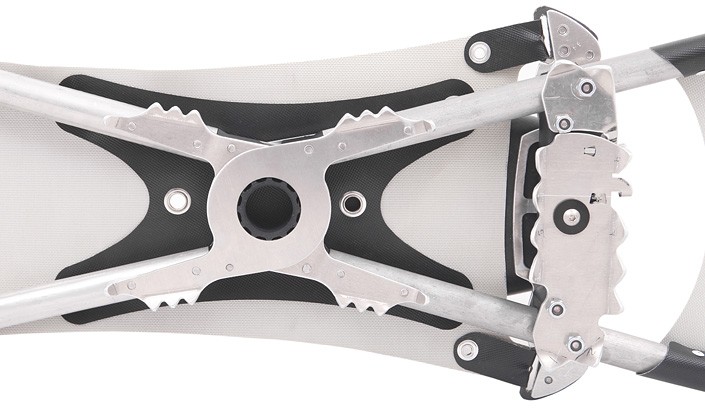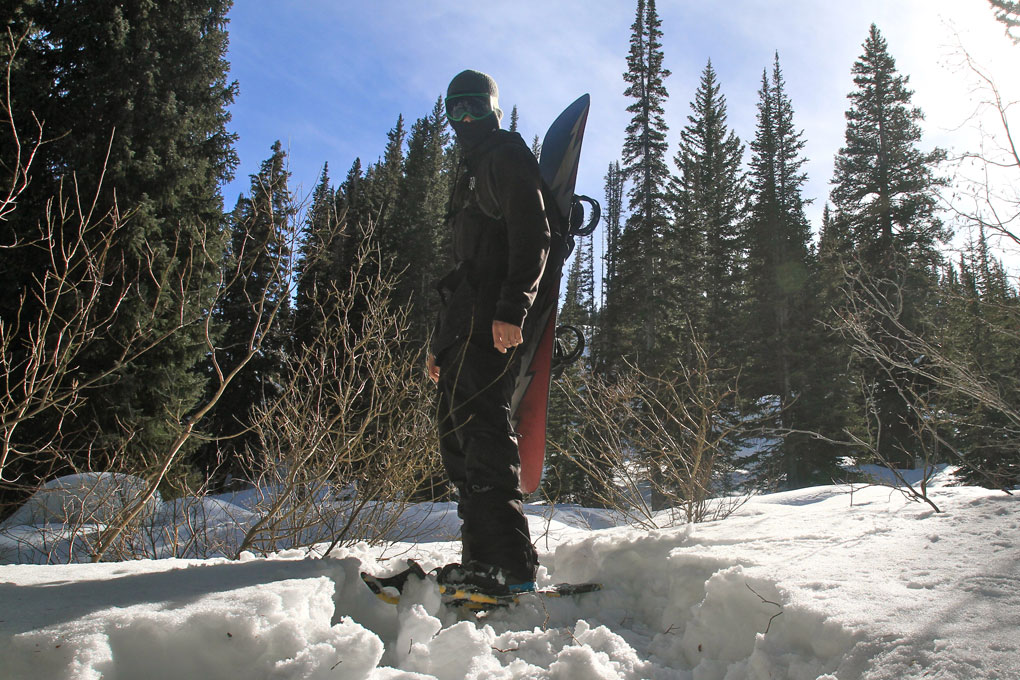Crampons
The crampons on the SnowXu are somewhat small (only 3/8 of an inch long, compared to inch-long crampons on my Atlas 825s) and extend barely beyond the footprint of the user’s foot. The large, non-cramponed portion of the canvas combined with the slick aluminum frame offer little traction on windblown or well-packed trails. On these slopes, the small crampons were often insufficient to bite and hold, and I frequently found myself sliding backward with each step.

Steep hill climbs presented a similar problem, as the short crampons slipped more with each step than other models I have used (most notably the Atlas 825). And because the front of the snowshoe is not rigid, it was difficult to kick the toe into the snow to gain additional footing.
In building a lightweight, collapsible snowshoe, some design tradeoffs are inevitable, and I suspect that’s the case with the crampons: anything larger would likely get in the way when folding the shoes shut. Plus, in conditions other than packed or windblown snow, the crampons held fine, so for more casual and recreational uses besides backcountry snowboarding, I don’t see this being as much of an issue. Just be aware that the SnowXu may not offer as much traction as other snowshoes with larger crampons.
Transitioning

At the trailhead or the end of a hike, transitioning out of the SnowXus was quick and easy. Opening and closing the SnowXu requires pulling only one small lever, a task that can be done with one gloved finger. All that is required is the snowshoes be spread apart, and the level pushed down to the locked position. The lever didn’t freeze up, and remained easy to use even after hiking for an hour in variable conditions.
Packability
One of the key design features of the SnowXu, of course, is its packability. The lighter weight and narrow profile when collapsed make them much easier to store in general than traditional snowshoes. When touring, however, I found the best way to store them was to lash them diagonally to the exterior of my pack.
At 33 inches long, the SnowXu measures a good eight inches longer than other snowshoes I’ve used. This means that they are too long to fit inside my typical backcountry day touring backpack (the 25-liter Dakine Mission pack), and when strapped vertically to the outside, they extend a few inches above the top of the bag.
This initially caused me some concern, because if I were to fall while riding, I would worry about being hit in the back of the neck or head with the tip of my snowshoe frame. (Other snowshoes I have used have a rounded frame and extend very minimally above the top of my pack, so this wasn’t as much of a concern.) Again, this is a non-issue when the shoes are strapped diagonally to my pack, I just found it a bit more tedious to secure them that way.
Durability
The SnowXu snowshoes I received were from the company’s first production run, and before they arrived, they alerted me to a few small issues I might encounter (a screw possibly coming loose that connected the logo to the top plate, and end caps possibly coming off), issues that have since been resolved.
I didn’t encounter either of those issues, but my very first time in the SnowXus, one of the rivets connecting the canvas to the side of the frame came unattached and lost in the snow. A small portion of the canvas came unfixed from the frame but was easily mended with a few stitches of heavy-duty thread, where the rivet originally was.
That was the only issue I had with the SnowXus over the three months I’ve been using them. But it did give me some reservations about taking the SnowXu’s deep into the backcountry or on a multi-day hike, where repairs might not be possible and spare parts are limited.
Again, I’ve seen no indication and have no reason to believe any problems are imminent, but I am hard on my gear and feel more comfortable when I know my gear can perform in whatever degree of variable conditions the day presents. For me personally, the SnowXu did not meet those requirements. But for a recreational rider or casual snowshoer, I have no doubt that the SnowXu will suffice.
General Thoughts
SnowXu is a new company looking to address some of the common drawbacks of traditional snowshoes, namely packability and weight. In many ways, they succeed. The size, ease of use, and minimal weight of the SnowXu make them a very attractive method of getting into the backcountry, but I don’t think they are ready quite yet to be used exclusively for backcountry snowboard use.

My main concerns were the size and number of crampons, both of which I’d like to see increased, as well as the unstable binding system, which I think could benefit from additional toe adjustability, a more secure connection to the base, and some added traction on the deck below the boot sole.
And again, keep in mind that the snowshoe I was on was one of SnowXu’s first production runs, and to make a collapsible, lightweight snowshoe marketed for a range of users and uses, it appears less emphasis was put into these features of the snowshoe. As such, they performed best on powder, when the crampons were less important and they could capitalize on their surface area to stay afloat, but worked less well on steep or packed terrain.
That said, the overall floatation of the SnowXu, while ample, was also slightly less than similar sized models (Atlas 830 and Atlas 930, both of which have 222 square inches of surface area compared to the SnowXu’s 180).
Bottom Line
I was interested in the SnowXu Collapsible Snowshoe to use exclusively for backcountry snowboarding, so for obvious reasons have focused on its performance there. That said, while the SnowXu is an innovative and promising snowshoe design that should appeal to a lot of people, I don’t think it’s ready for serious backcountry snowboarding. For long tours or highly variable terrain, a more traditional backcountry access method would (for now) be a better choice, though I’ll look forward seeing what changes SnowXu might incorporate into future production runs.
If, however, you’re looking for a quick, lightweight, and easy way to gain some floatation on short tours or fast laps, or for general or recreational use where boots aren’t enough and traditional snowshoes are too much, the SnowXus are worth keeping in mind.
